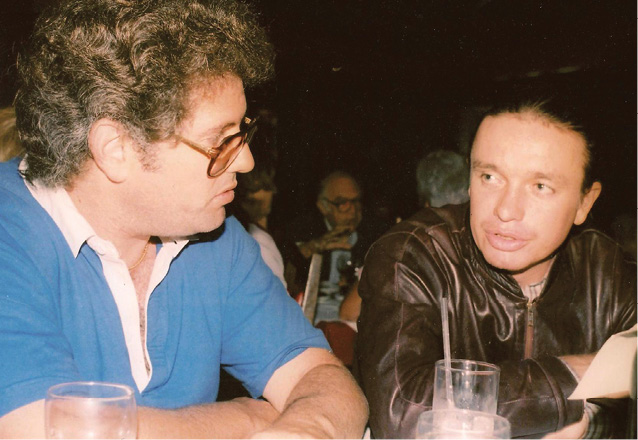4
The Hendrix of the Electric Bass
When you’re young, you feel bulletproof. You often think that you’re the “stuff,” and that nothing will stand in the way of your goal. Even though I was in my early twenties back then, after spending some time in LA, I could see that there were many obstacles in the way of making it in the music business. Sometimes they had to do with talent, and sometimes they had to do with luck. You needed at least a bit of both to get any traction. Along those lines, I often thought about a musician who had a big impact on me back in Fort Lauderdale, a couple of years before I made the move to LA.

Norman and Jaco Pastorius, early ’70s, at Monty’s Restaurant. (Photo by Marlene Harris)
We had been auditioning to play in a club called The She in Fort Lauderdale, which was owned by the same people who owned The Flying Machine. After playing a couple of tunes, we stepped outside to smoke a joint, and suddenly I heard some guy just ripping it to shreds on my Hammond B3. I walked inside, and there was this clean-cut, young seventeen-year-old kid just killing it, sounding like Jimmy Smith.
“Man, you sound great,” I told him.
The kid shrugged it off. “Well, I’m really a bass player.”
“Well, what the hell does that make me?” I asked, half-jokingly.
That was my introduction to the great Jaco Pastorius. After that, we became really close friends. My band, Katmandu, was pretty popular, and we’d often have Jaco’s band, Woodchuck, open for us. Woodchuck was a trio comprised of bass, drums, and Hammond B3, with the drummer, Bob Hertzog, doing all the singing. It was a crude set-up, but these clean-cut nerdy kids were just funkier than hell. They would do covers of “Peak of Love” by Bobby McClure, or “Ninety-Nine and a Half” by Wilson Pickett, and start the tune real straight, but by the third verse they’d be out there in the ozone, like Sun Ra.
The public really didn’t understand them, but every hip musician in town would come to check out what Jaco was doing. He just blew everybody else away. So much so, that a fine local bass player, Bob Bobbing, used to follow him around with a Wollensak tape recorder and record all his gigs, much like this cat Dean Benedetti did with Charlie Parker. Thank God he did, for these killer cuts all made it into the excellent Jaco: The Early Years CD.
Jaco was a modest, straitlaced-looking innocent, compared with us long-haired wild men. Drug and alcohol free. In other words, very different from what his image was to become, years later.
He once said to me, “You guys will probably do well. You guys play good. You got the whole look down and everything.”
But the truth was, Jaco and his trio just buried us. I knew it in my heart. But I also knew there was a big possibility that Jaco would just languish in the Miami scene. It was a crapshoot. The general audiences, not understanding Jaco, showed how arbitrary the music business was. Even if you were the best, it didn’t necessarily mean shit.
Back in Miami, I had a refinished dot neck Jazz Bass that Jaco desperately wanted. I ended up trading it to him for a fairly clean four-by-ten Bassman amp. (This bass is all over the Jaco, the Early Years booklet.) Jaco later sold that bass to a Miami musician and friend of mine, John Paulus, who later came out to play in one of my LA bands in the early seventies, the Angel City Rhythm Band.
Paulus later played with John Mayall for many years. After owning the bass for quite a few years, Paulus figured it was time to part with it. Because I had been one of its first owners and knew all about its history, he asked me to help him sell it. With that history, we easily sold it to a collector in Japan, where it resides still. An authentic Jaco bass—an amazing and iconic piece of music memorabilia.
•••
Mike Pinera was another case in point. As the driving creative force in the Blues Image, he was at the top of the list of the heaviest guitar players in town. Whenever Hendrix or Cream came to Miami, he was the one they wanted to jam with. When the Blues Image knocked it out of the park with “Ride Captain Ride” (still one of the catchiest songs of the era), there was no doubt in anybody’s mind that the group would go right to the top. They were that good. Instead, the record label induced Mike to join the Iron Butterfly with a big signing bonus. The Blues Image, even with Mike Pinera, one of the best groups I’d ever heard, became a proverbial one-hit wonder, and the Iron Butterfly continued their descent into metal obscurity. One wrong move and all that promise, down the drain.
So in hindsight, all those older instruments I was buying, selling, and stashing away were my security blanket. I brought about fifty or sixty with me to LA in 1970. The demand for them was consistent, while the success or failure of a group was unpredictable.